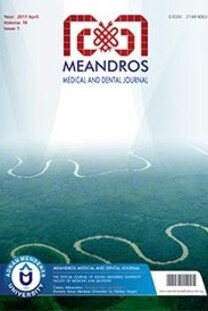EGE DOĞUMEVİ VE KADIN HASTALIKLARI EĞİTİM VE ARAŞTIRMA HASTANESİ, AİLE PLANLAMASI BÖLÜMÜ'NE 2001-2005 YILLARI ARASINDA BAŞVURAN PERİMENOPOZAL KADINLAR TARAFINDAN KULLANILAN KONTRASEPTİF YÖNTEMLER
Perimenopoz, kontrasepsiyon, Ege bölgesi
Contraceptive Methods Used by Perimenopausal Women Who applied Aegean Obstetrics and Gynecology Training and Research Hospital, Family Planning Unit in between 2001-2005
Perimenopause, contraception, Aegean region,
___
- 1. Kleinman RL. Contraception for younger and older women. Family Planned Parenhood Federation. StephenAustin and Sons Ltd, 1988: 210-22
- 2. Göl M, Aydın Ç, Güven CM, Yensel U, Karcı L, Baloğlu A. 40 yaş ve üzeri kadınlarda gebelik sonuçları. MN-Gynecol Obstet & Reprod Med 2003; 9: 176-79
- 3. Szarewski A, Guillebaud J. Contraception at special times. Contraception: A Users Handbook, Chapter 12. Bungays, Suffolk: Oxford University Pres, 1994: 188- 98
- 4. de Vries E, den Tonkelaar I, van Noord PA, van der Schouw YT, te Velde ER, Peeters PH. Oral contraceptive use in relation to age at menopause in the DOM cohort. Hum Reprod 2001; 16: 1657-62
- 5. Sherif K. Benefits and risks of oral contraceptives. Am J Obstet Gynecol 1999; 180: 343-48
- 6. Suwikrom S, Jaisamrarn U. Comparison of the metabolic effects of oral contraceptive and nonhormonal contraceptive use in women over 45 years old. Contraception 2005; 71: 183-7
- 7. Senanayake P, Potts M. Contraception for special groups. An Atlas of Contraception. Spain: Parthenon Publishing Group Ltd, 1995; 99-106
- 8. World Health Organization. Improving Acces to Quality Care in Family Planning: Medical Eligibility Criteria for Contraceptive Use. Geneva;WHO, 1996
- 9. Speroff L, Darney P. Clinical guidelines for contraception at different ages. A Clinical Guide for Contraception, 2 nd ed.Baltimore; Williams&Wilkins, 1996: 295-321
- 10. Belaisch J. Contraception during the perimenopause. Presse Med 2003; 12; 32: 647-54
- 11. Skouby SO. Contraceptive use and behavior in the 21st century: a comprehensive study across five European countries. Eur J Contracept Reprod Health Care 2004; 9: 57-68
- 12. Galazios G, Emin M, Koutlaki N, Dafopoulos K, Li b e ri s V, A n a st a si a di s P. Differentiation in contraceptive behavior of the female population in Thrace, Greece. Eur J Contracept Reprod Health Care 2001; 6: 78-86
- 13. Cebeci Save D, Erbaydar T, Kalaca S, Harmanci H, Cali S, Karavus M. Resistance against contraception or medical contraceptive methods: a qualitative study on women and men in Istanbul. Eur J Contracept Reprod Health Care 2004; 9: 94-101
- 14. Ozgur S, Bozkurt AI, Sahinoz S, Ozcirpici B, Sahinoz T, Saka G, et al. Family planning in the Southeast Anatolian Project Region. Eur J Contracept Reprod Health Care 2004; 9: 78-88
- 15. Carr BD. The transition from hormonal contraception to HRT. Menapause Management 1994; 1: 11
- 16. Türkiye Cumhurriyeti Sağlık Bakanlığı. Türkiye Nüfus ve SağlıkAraştırmasıRaporu 2003,Ankara.
- 17. Taneepanichskul S, Dusitsin N. Contraception in perimenopause. J MedAssoc Thai 2003; 86: 140-44
- 18. Güldal D, Şemin S, Tepe G. Aile planlamasında erkekler nerede? Dokuz Eylül Üniversitesi Tıp Fakültesi Dergisi 2001; 15: 231-38
- 19. Bhathena RK, Guillebaud J. Contraception for older woman: an update. Climacteric 2006; 9: 264-76
- 20. Shaaban MM. The perimenopause and contraception. Maturitas 1996; 23: 181-92
- 21. French R, Van Vliet H, Cowan F, Mansour D, Morris S, Hughes D, et al. Hormonally impregnated intrauterine systems (IUSs) versus other forms of reversible contraceptives as effective methods of preventing pregnancy. Cochrane Database Syst Rev 2001; 2: CD001776
- ISSN: 2149-9063
- Yayın Aralığı: 4
- Başlangıç: 2000
- Yayıncı: Aydın Adnan Menderes Üniversitesi
Erdal GEZER, Selda ŞEN, Bakiye UĞUR, Osman Nuri AYDIN, Mustafa OĞURLU, Feray GÜRSOY
EGE VE ADNAN MENDERES TIP FAKÜLTELERİNDE UZMANLIK EĞİTİMİ Tıpta Uzmanlık Öğrencisi Bakış Açısı İle
Bülent Kadri GÜLTEKİN, Aydın SÖYLEMEZ, İ. Ferhan DEREBOY, Candan ÇİÇEK
GEÇ BULGU VEREN PENETRAN SUBCLAVİAN ARTER YARALANMASI: OLGU SUNUMU
Muhip KANKO, Şadan YAVUZ, Salih TOPÇU, Ersan OZBUDAK, Turan BERKİ
Murat İNAL, Yusuf YILDIRIM, Kenan ERTOPCU, İsa ÖZELMAS, Şivekar TINAR
Pınar OKYAY, Gonca ATASOYLU, Demet METEOĞLU, Hüseyin DEMİRÖZ, Mehmet ÇOBANOĞLU, Erdal BEŞER
Alparslan ÜNSAL, Füsun TAŞKIN, İbrahim METEOĞLU, Burçin UZ, Can Zafer KARAMAN
Sedat SOYUPEK, Abdullah ARMAĞAN, Hakkı PERK, Alim KOŞAAR, Tekin Ahmet SEREL, Alper ÖZORAK
PEDİYATRİK CERRAHİDE KAUDAL ANALJEZİ ETKİNLİĞİNİN RETROSPEKTİF OLARAK DEĞERLENDİRİLMESİ
Erdal GEZER, Bakiye UĞUR, Selda ŞEN, Mustafa OĞURLU, Osman Nuri AYDIN, Feray GÜRSOY
KARPAL TÜNEL SENDROMUNDA KLİNİK VE ELEKTROFİZYOLOJİK EVRELEMELERİN KARŞILAŞTIRILMASI
Tuğba TUNÇ, Gülnihal KUTLU, Özlem COŞKUN, Emine Esra OKUYUCU, Leyla ÇAVDAR, Levent Ertuğrul İNAN
